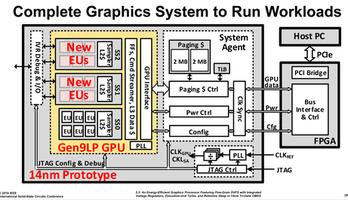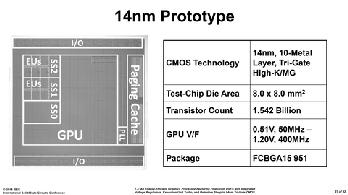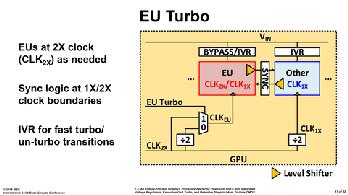At the IEEE International Solid State Circuits Conference in San Francisco late last week, Intel unveiled plans for a prototype discrete GPU. Designed to be built on Intel's 14nm process, the early test chip would feature 1.5 billion transistors and its clock speeds would range between 50 and 400MHz, reports Notebook Check (via PCWatch, Japan), indicating a leaning towards efficiency over raw performance.
Intel has made great progress in its integrated graphics chips over recent years. However, for any kind of modern 3D games, even its best efforts just scrape by - requiring lower detail settings, resolutions, and delivering lower fps than entry-level discrete GPUs can. On a portable platform it's easy to understand the thrifty power budgets Intel strains to keep within for its CPUs with integrated graphics.
 |
 |
Things do look set to change, though, with the Intel 8th gen Core G-series processors, combining AMD Radeon Vega cores, which will initially target portables. Additionally, AMD's former chief GPU architect Raja Koduri joined Intel back in November last year. A statement at the time of Koduri's appointment said "Koduri leads the expansion of Intel’s leading position in integrated graphics for the PC market with discrete graphics solutions for a broad range of computing segments". Furthermore, at that time Intel said that it plans to "aggressively expand our computing and graphics capabilities".
Perhaps this is too early to see a GPU design with any significant input from Koduri, but Intel chose to tease the ISSCC attendees about its first dGPU anyway. Key revelations about the prototype dGPU are that it:
- Is a 14nm design,
- The design is based on Intel's 9th generation graphics architecture,
- It consists of 1.5 billion transistors,
- Frequency ranges from 50MHz at 0.51 volts up to 400MHz at 1.2 volts, respectively,
- There's an EU Turbo mode to double clocks as required,
- The chip is divided between execution units alongside a system agent, and an FPGA to connect to the PCIe bus
 |
 |
It is not known whether this prototype chip will every become part of a shipping product but it is a sign that Intel will reach higher to compete with discrete PC GPU makers in the coming months / years.
Update from Intel:
HEXUS has received an email from Intel clarifying the purpose of the prototype GPU it unveiled at ISSCC:
“Last week at ISSCC, Intel Labs presented a research paper exploring new circuit techniques optimized for power management. The team used an existing Intel integrated GPU architecture (Gen 9 GPU) as a proof of concept for these circuit techniques. This is a test vehicle only, not a future product. While we intend to compete in graphics products in the future, this research paper is unrelated. Our goal with this research is to explore possible, future circuit techniques that may improve the power and performance of Intel products.”






